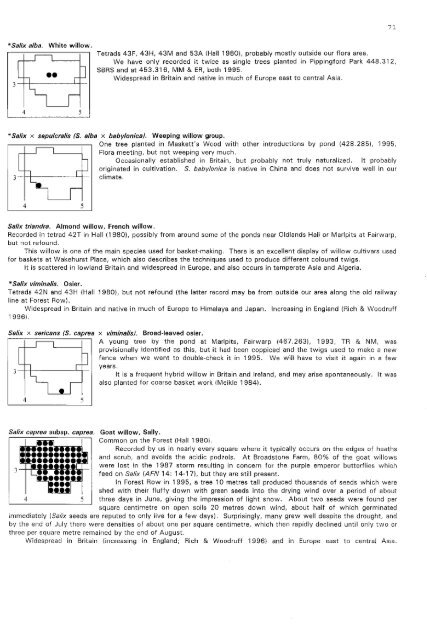Flora of Ashdown Forest - Botanical Society of the British Isles
Flora of Ashdown Forest - Botanical Society of the British Isles
Flora of Ashdown Forest - Botanical Society of the British Isles
Create successful ePaper yourself
Turn your PDF publications into a flip-book with our unique Google optimized e-Paper software.
71* Salix alba. White willow.3 -+-t-----'-_t_Tetrads 43F, 43H, 43M and 53A (Hall 1980), probably mostly outside our flora area.We have only recorded it twice as single trees planted in Pippingford Park 448.312,SBRS and at 453.316, MM & ER, both 1995.Widespread in Britain and native in much <strong>of</strong> Europe east to central Asia.4 5*Salix x sepulcralis (S. alba x babylonica). Weeping willow group.One tree planted in Maskett's Wood with o<strong>the</strong>r introductions by pond (428.285), 1995,<strong>Flora</strong> meeting, but not weeping very much.Occasionally established in Britain, but probably not truly naturalized. It probablyoriginated in cultivation. S. baby/onica is native in China and does not survive well in our3 climate.4 5Salix triandra. Almond willow, French willow.Recorded in tetrad 42T in Hall (1980), possibly from around some <strong>of</strong> <strong>the</strong> ponds near Oldlands Hall or Marlpits at Fairwarp,but not refound.This willow is one <strong>of</strong> <strong>the</strong> main species used for basket-making. There is an excellent display <strong>of</strong> willow cultivars usedfor baskets at Wakehurst Place, which also describes <strong>the</strong> techniques used to produce different coloured twigs.It is scattered in lowland Britain and widespread in Europe, and also occurs in temperate Asia and Algeria.*Salix viminalis. Osier.Tetrads 42N and 43H (Hall 1980), but not refound (<strong>the</strong> latter record may be from outside our area along <strong>the</strong> old railwayline at <strong>Forest</strong> Row).Widespread in Britain and native in much <strong>of</strong> Europe to Himalaya and Japan. Increasing in England {Rich & Woodruff19961.Salix x sericans (S. caprea x viminalis). Broad~leaved osier.A young tree by <strong>the</strong> pond at Marlpits, Fairwarp (467.263), 1993, TR & NM, wasprovisionally identified as this, but it had been co pp iced and <strong>the</strong> twigs used to make a newfence when we went to double-check it in 1995. We will have to visit it again in a fewyears.3 -++------"'--1--It is a frequent hybrid willow in Britain and Ireland, and may arise spontaneously. It wasalso planted for coarse basket work (Meikle 1984).4 5Salix caprea subsp. caprea. Goat willow, Sally.Common on <strong>the</strong> <strong>Forest</strong> (Hall 1980).Recorded by us in nearly every square where it typically occurs on <strong>the</strong> edges <strong>of</strong> heathsand scrub, and avoids <strong>the</strong> acidic podzols. At Broadstone Farm, 80% <strong>of</strong> <strong>the</strong> goat willowswere lost in <strong>the</strong> 1987 storm resulting in concern for <strong>the</strong> purple emperor butterflies whichfeed on Salix (AFN 14: 14-1 7), but <strong>the</strong>y are still present.In <strong>Forest</strong> Row in 1995, a tree 10 metres tall produced thousands <strong>of</strong> seeds which wereshed with <strong>the</strong>ir fluffy down with green seeds into <strong>the</strong> drying wind over a period <strong>of</strong> aboutthree days in June, giving <strong>the</strong> impression <strong>of</strong> light snow. About two seeds were found persquare centimetre on open soils 20 metres down wind, about half <strong>of</strong> which germinatedimmediately (Sa/ix seeds are reputed to only live for a few days). Surprisingly, many grew well despite <strong>the</strong> drought, andby <strong>the</strong> end <strong>of</strong> July <strong>the</strong>re were densities <strong>of</strong> about one per square centimetre, which <strong>the</strong>n rapidly declined until only two orthree per square metre remained by <strong>the</strong> end <strong>of</strong> August.Widespread in Britain (increasing in England; Rich & Woodruff 1996) and in Europe east to central Asia.
















